June 7, 2013
Visit to the Astronomy Reserve Collection at Kidbrooke
Report by: Mike Dryland
We were very fortunate to be taken to see the astronomy reserve collection by curator Dr Rebekah Higgitt. In common with many of the team, Becky is very busy just now with a number of projects including preparations for the special exhibition to mark the 2014 tercentenary of the Longitude Act. She is also preparing for her move to the University of Kent later in the year so we were doubly lucky to get into her crowded schedule before she has to leave us.
Kidbrooke is a secure storage site not open to the public. It is a veritable Aladdin’s cave of objects. In fact the astronomy collection is in the minority – Kidbrooke mainly holds nautical objects ranging from all kinds of navigational equipment, through furniture, to ship’s bells, lights, binnacles, and weapons.
Two groups each of around 10 Flamsteed members could be accommodated, and spent over an hour touring the store. Becky showed us round and gave an excellent commentary on the astronomy items, often with intriguing background on how they were acquired.
We began with some horology items including two splendid Dent regulators: one built for use with the 19th Century expeditions to observe the Transit of Venus; the other a fabulous piece made for the Pulkovo Observatory in Russia but never sent. Part of its movement was devised by the seventh Astronomer Royal, the formidable Sir George Airy.
On to the heart of the astronomy collection which contains several Herschel items – a fabulous 7-foot (length) Newtonian reflector built by Sir William, and also one of the spare 4-ft diameter mirrors from his legendary 40-foot reflector. Herschel’s mirrors were polished from speculum metal and the 4-ft mirror must weigh a good ton or several! The remains of the 40-ft tube are displayed near the admissions area at the ROG. Herschel erected it at his home near Slough.
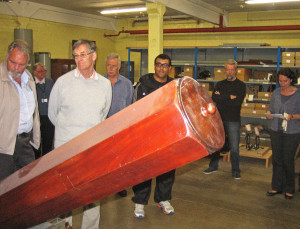 Nearby in the store, Becky pointed out the original mounting from the Greenwich Astrographic telescope (now at Herstmonceux), and the Sheepshanks refractor presented to the Observatory by the eponymous Rev. and mounted at one time in the Altazimuth Pavilion. There are also several observer’s chairs including that from the 28-inch, parts of Airy’s ‘water clock’ (the original water turbine from the 12.75-inch Merz?), and Airy’s water telescope (built in 1870 to see if the coefficient of sidereal aberration depended on the medium through which light passed – it doesn’t. Pay attention now! There will be a test).
Nearby in the store, Becky pointed out the original mounting from the Greenwich Astrographic telescope (now at Herstmonceux), and the Sheepshanks refractor presented to the Observatory by the eponymous Rev. and mounted at one time in the Altazimuth Pavilion. There are also several observer’s chairs including that from the 28-inch, parts of Airy’s ‘water clock’ (the original water turbine from the 12.75-inch Merz?), and Airy’s water telescope (built in 1870 to see if the coefficient of sidereal aberration depended on the medium through which light passed – it doesn’t. Pay attention now! There will be a test).
Moving on, we looked at a couple of small altazimuth telescopes also used for Transit of Venus expeditions, Airy’s dip circle (for geo-magnetic measurement), and an intriguing machine built to train observers for occultation observations. Becky then turned to some small items – more Herschel objects (tiny eye-pieces and a small but surprisingly heavy mirror), and a number of documents from the archive of Sir Frank Dyson (ninth A-R, 1910-1933), including a photograph album containing pictures of each observatory staff member at the time of his retirement.
Finally we looked at some ‘props’ – small scale models made for the 1975 exhibition which celebrated the tercentenary of the founding of the Greenwich Observatory. Models were made of all the early observational instruments and we were able to examine those showing Flamsteed’s mural quadrant and equatorial sextant – the originals are both lost.
It was time to gather up the visitors – very hard to resist the urge to wander off into dark corners to see what strange objects could be unearthed! Like herding cats! Back to the reception area (with short digressions to peek at some fabulous ship models, and also the ‘computers’ table’ once in the Octagon Room and possibly used for meetings of the ROG Board of Visitors).
- Modern antique? The Rugby time signal system c1980s
- Model of Flamsteed’s mural quadrant c1689. Removed 1720 and now lost. Model made for the 1975 exhibition
- Superb model of the Observatory c1680. Prepared for the 1975 tercentenary exhibition
- “How do you fire this thing?” Mike D shows a firm grasp of the operation of a 7-ft Newtonian by William Herschel
Many thanks indeed to Rebekah Higgitt, and to Kidbrooke store manager Bernie Bryant, for taking the time and trouble to prepare for our visits and show us round.
Kidbrooke is a quite amazing place – evocative of the ‘old’ National Maritime Museum, very object-rich and much loved and missed by many. We resolved to start a campaign to found a museum in Greenwich to display some of these maritime treasures now hidden away. The Sammy Ofer Wing is crying out to be peppered with nautical objects, and the ‘art gallery’ now on the site of the old NMM could do with some proper nautical competition!
Pictures from the trip (by Mike Dryland):
Posted under: Flamsteed, History of Astronomy, Meeting Report, Society Trip
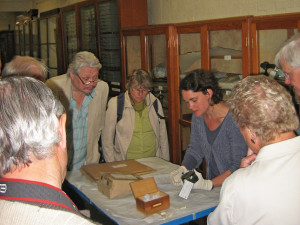
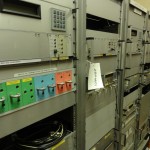
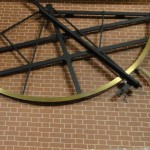
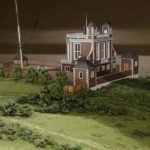
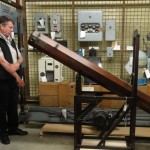









You must be logged in to post a comment.